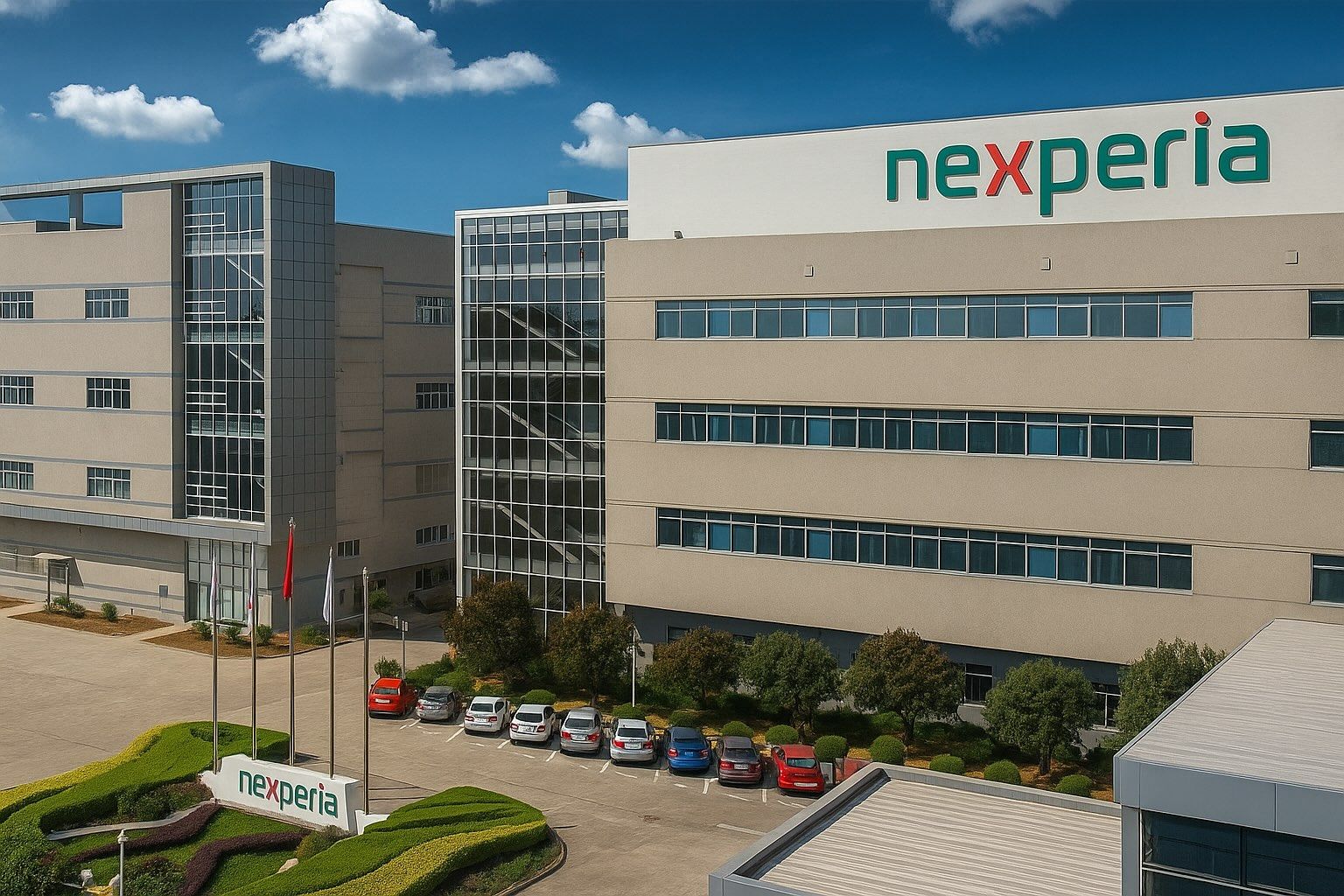- Nexperia Halt: Dutch-based chipmaker Nexperia (owned by China’s Wingtech) suspended deliveries from its Chinese plant on Oct 26, blaming “failure to comply with… contractual payment terms” [1] after the Netherlands seized control of the company on national-security grounds.
- China’s Ban: In retaliation, China’s commerce ministry barred exports of Nexperia chips on Oct 4 [2]. Automakers warn this shortfall could stop production: the European Automobile Manufacturers’ Association (ACEA) says existing chip inventories cover only a few weeks and could bring manufacturing to a halt [3]. German industry body ZVEI even warned of a “standstill in large parts of the worldwide automotive production” if the crisis drags on [4].
- Automakers Brace: Carmakers worldwide are scrambling. Nissan says it has enough Nexperia chips “to last until the first week of November” [5]; Honda halted a plant in Mexico. VW and Mercedes report no immediate cuts but are reviewing short-term impacts [6] [7]. U.S. automakers (GM, Ford, Stellantis, etc.) have similarly warned production could be hit by early November [8].
- Diplomatic Efforts: High-level talks are underway. The EU’s trade and tech chiefs met Chinese officials in Brussels to de-escalate the spat, and China agreed to “continue engagement” on export controls [9]. Most dramatically, a new US–China trade truce (announced Nov 1) reportedly includes resuming Nexperia’s chip exports. Reuters reports that the Biden administration will soon confirm shipments from Nexperia’s China facilities will resume [10] [11], and Beijing says it will “comprehensively consider… and exempt eligible exports” of Nexperia chips [12].
- Stock Impact: Share prices have been volatile. Wingtech’s Shanghai-listed stock (Nexperia’s parent) plunged 10% on the Dutch takeover news [13], then rebounded to ~45 CNY by Nov 1 [14]. Major chip suppliers have seen mixed effects – chipmakers serving autos like NXP Semiconductors are raising guidance on stronger auto demand [15], while automaker stocks remain sensitive to supply risk (e.g. VW shares at multi-year lows near €90–95 [16]).
What’s Going On with Nexperia and China
Nexperia is a Dutch semiconductor firm (spun out from Philips) that makes mature power-control chips (diodes, transistors, MOSFETs) used ubiquitously in cars and electronics [17] [18]. In late September 2025 the Dutch government invoked emergency powers, taking over Nexperia and ousting its China-appointed CEO on national-security grounds. The move was triggered by U.S. pressure (Wingtech, Nexperia’s Chinese owner, was blacklisted) and fears that Nexperia’s technology might transfer to China [19] [20].
Beijing quickly retaliated. On Oct 4 China’s commerce ministry issued an export ban blocking Nexperia’s China factories from sending chips abroad [21] [22]. In practice this cut off about 70% of Nexperia’s output (Nexperia wafers are made in Europe but packaged/tested in China) [23]. The result: Nexperia informed customers on Oct 26 that it could no longer honor contracts for its Chinese plant, citing a payment dispute as the official reason [24]. In reality, the corporate wrangle reflects geopolitical tensions. Nexperia’s interim CEO said the supply halt was “a direct consequence of the local management’s… failure to comply with agreed payment terms” [25] – essentially a stand-in explanation for a trade war.
Despite the rhetoric, Nexperia insists it wants to fix the problem. Company officials have said they hope to resume shipments once payments issues are cleared, and even “wanted to de-escalate the situation” [26]. But the global alarm has already been raised. The EU is pushing for solutions: Trade Commissioner Šefčovič and Tech Commissioner Virkkunen have been in talks with Chinese counterparts, and the EU has highlighted the episode as proof of why a new Chips Act (with stockpiles and supply-chain visibility) is needed [27]. EU officials also won concessions on other trade tensions (rare-earth exports) during China talks [28]. In Brussels on Nov 1 they announced that China will “continue engagement on… export control policies” and explicitly planned to discuss Nexperia [29].
Global Auto Production at Risk
Because Nexperia’s chips are small and cheap (often just a few cents each) they normally go unnoticed – but they are everywhere in a car’s electronics [30] [31]. They handle battery power, lights, sensors, braking, infotainment, etc. Modern vehicles use hundreds of such discrete components [32] [33]. Carmakers cannot simply pause or reorder these parts quickly: switching to other suppliers involves lengthy re-testing and approval. As one analysis put it, “switching to alternative suppliers means recertifying components… a process that cannot be compressed into days or weeks” [34] [35].
Industry groups have raised the alarm. The European Automobile Manufacturers’ Association (ACEA) said current chip stocks will last just weeks and warned that assembly lines could halt if Nexperia supplies don’t resume [36]. ACEA director Sigrid de Vries said the disruption would affect “virtually all of our members” and could not be contained to one region [37]. In Germany, the trade association ZVEI bluntly warned of a “standstill in large parts of the worldwide automotive production” if the export stop continues [38]. Likewise in the U.S., the Alliance for Automotive Innovation (representing GM, Ford, Toyota, etc.) urged a quick fix, with CEO John Bozzella saying “if the shipment of automotive chips doesn’t resume – quickly – it’s going to disrupt auto production in the U.S. and many other countries” [39].
Automakers are already feeling the pain. Nissan’s chief performance officer openly warned at a Tokyo show, “it’s a big issue” and admitted they only have enough chips to last into the first week of November [40]. Nissan, Honda and others have started to triage – shuffling supply between plants and revising schedules. Honda halted one Mexican factory and is adjusting North American output [41]. Luxury brands Mercedes and BMW say they’re “covered” in the very short term (thanks to stockpiles), but are hunting for alternatives as backup [42] [43]. VW – Europe’s largest carmaker – says its German plants will run another week without interruption, but it is “in close contact” with suppliers on the issue [44] [45]. VW CFO Arno Antlitz has warned of tough measures ahead, noting that VW’s profits are under pressure and any downtime “would be another blow” [46].
Some suppliers are preparing contingency plans. German parts giant Bosch is reportedly drawing on alternate vendors and optimizing inventory, while warning it may furlough workers at its chip-making plants if the dispute is not resolved [47] [48]. Suppliers say that Infineon, NXP and Texas Instruments could partly fill Nexperia’s role, but qualifying even similar chips for automotive use takes months [49]. In short, carmakers have emergency measures in place, but they have repeatedly said: we learned from 2021’s chip crunch – we cannot afford a repeat. The political leadership is on alert: EU and Dutch officials are in urgent contact with China, and the Dutch economy minister plans to meet a senior Chinese counterpart to hammer out a deal [50].
US–China Trade Deal and Export Curbs
In a dramatic twist, discussions during the Nov 1 APEC summit (South Korea) apparently unlocked a short-term fix. The White House is expected to release a fact sheet confirming that, under the new trade truce brokered by President Trump and Xi Jinping, Nexperia’s China plants will resume exports [51] [52]. Reuters reports that China will “consider exemptions for Nexperia chip exports” after “comprehensively” assessing eligible orders [53]. Bloomberg and Reuters cite unnamed officials saying this was agreed in the US–China deal.
If carried out, the impact would be enormous. High-volume chips that suddenly became scarce could flow again – averting the most immediate shutdown risk. Indeed, on Nov 1 Chinese officials confirmed they will review and exempt orders from Nexperia under the ban [54]. This statement – together with the fact-sheet announcement – sent markets a relief rally.
Still, the situation remains delicate. The deal likely requires Nexperia to accept certain conditions or guarantees (e.g. about governance or use of its technology) for export approval. The EU has also demanded clarity: Maroš Šefčovič said China agreed that the export curbs it imposed in October do not apply to the EU, and talks will continue [55]. Meanwhile, EU tech commissioner Virkkunen’s meeting with Nexperia’s management emphasized lessons learned: Europe needs better chip-stock visibility, investment incentives and reserve buffers to avoid future shocks [56].
Market Impact and Outlook
The chip war and its diplomatic resolution have rippled through markets. Wingtech Technology (Nexperia’s owner) is listed in Shanghai (ticker 600745.SS). Its stock spiked when a resolution seemed likely: trading at about 45.00 CNY on Nov 1, up ~3% on the day [57], and close to its 52-week high of 50.98 CNY [58]. This marks a big recovery from recent lows (Wingtech was ~27 CNY mid-2025). The surge reflects eased fears: investors welcome the fact that chip exports may resume.
On the broader semiconductor market, companies serving the auto sector have already been performing well. For example, NXP Semiconductors (Netherlands) said on Oct 27 that its fourth-quarter revenue will exceed estimates thanks to improving auto demand [59]. Its shares rose on that news (up 6.6% so far in 2025) [60]. Infineon and other chipmakers reported similar trends of automotive segment growth. Analysts note that automakers are restocking now that tariff-driven pull-ins have eased, a tailwind for suppliers.
For automakers, the situation is double-edged. On one hand, resolving Nexperia’s supply bottleneck would remove a major near-term risk; on the other, it highlights how geopolitics can still threaten production. Car stocks (VW, BMW, etc.) are near multi-year lows as Wall Street watches the chip situation [61]. If the deal holds, automakers may get a temporary reprieve – but they also realize they need more resilience. Bosch and VDA executives are already urging governments to help create strategic chip inventories to prevent “significant production stoppages” in the future [62].
Forecast: If Nexperia chips flow again, auto production can normalize and anxiety will ease (Wingtech shares might stabilize, chip suppliers continue steady gains). However, if the dispute re-escalates or new restrictions emerge, expect renewed market volatility. For now, experts emphasize that the global auto industry has narrowly averted a shutdown – but it has also learned that even “commodity” chips can become critical during trade crises [63] [64]. As one German car body put it, this incident could lead to “significant production restrictions… and possibly even stoppages” unless supply issues are solved [65]. Industry analysts will be watching Beijing and The Hague closely in the coming weeks: any sign of resumed Nexperia shipments should calm markets, while delays could spark fresh jitters.
Sources: We synthesized recent reporting from Reuters, BBC, FT, The Guardian, and industry experts (including TechStock² analysis) to compile this report [66] [67] [68] [69] [70] [71]. Each cited source covers aspects of this evolving story, from the chipmaker dispute itself to the auto and stock-market fallout.
References
1. www.reuters.com, 2. ts2.tech, 3. ts2.tech, 4. ts2.tech, 5. www.theguardian.com, 6. www.reuters.com, 7. www.theguardian.com, 8. ts2.tech, 9. www.reuters.com, 10. www.reuters.com, 11. www.bloomberg.com, 12. www.reuters.com, 13. ts2.tech, 14. www.reuters.com, 15. www.reuters.com, 16. ts2.tech, 17. ts2.tech, 18. www.reuters.com, 19. www.reuters.com, 20. www.reuters.com, 21. ts2.tech, 22. www.reuters.com, 23. www.reuters.com, 24. www.reuters.com, 25. www.reuters.com, 26. www.theguardian.com, 27. www.theguardian.com, 28. www.reuters.com, 29. www.reuters.com, 30. ts2.tech, 31. www.reuters.com, 32. ts2.tech, 33. ts2.tech, 34. ts2.tech, 35. ts2.tech, 36. ts2.tech, 37. ts2.tech, 38. ts2.tech, 39. ts2.tech, 40. www.reuters.com, 41. www.theguardian.com, 42. www.theguardian.com, 43. ts2.tech, 44. www.reuters.com, 45. ts2.tech, 46. ts2.tech, 47. www.reuters.com, 48. www.reuters.com, 49. www.reuters.com, 50. ts2.tech, 51. www.reuters.com, 52. www.bloomberg.com, 53. www.reuters.com, 54. www.reuters.com, 55. www.reuters.com, 56. www.theguardian.com, 57. www.reuters.com, 58. www.reuters.com, 59. www.reuters.com, 60. www.reuters.com, 61. ts2.tech, 62. www.theguardian.com, 63. ts2.tech, 64. www.reuters.com, 65. www.theguardian.com, 66. www.reuters.com, 67. www.reuters.com, 68. ts2.tech, 69. www.theguardian.com, 70. www.theguardian.com, 71. www.reuters.com






